Rising to an majestic height of 6,189 meters (20,305 feet), Island Peak Weather Conditions can go from from heavy snowfall to clear blue skies, which also offers an exhilarating challenge to mountaineers and trekkers alike.
Island Peak Weather Conditions on Spring (March to May)
Spring is considered one of the best seasons to visit Island Peak. The weather during this time tends to be relatively stable, with mild temperatures and clear skies. As the season progresses, the temperatures gradually rise, making it more comfortable for climbers.
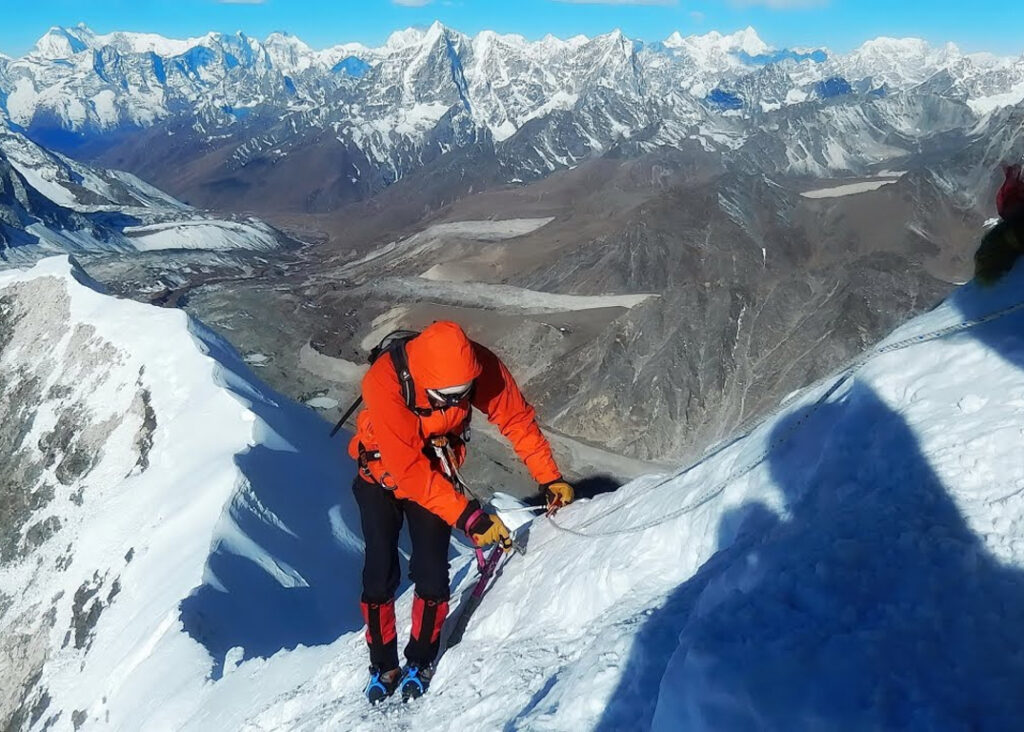
In March, temperatures can range from -10°C (14°F) at night to 10°C (50°F) during the day. By May, the mercury hovers around -5°C (23°F) at night and reaches 15°C (59°F) during the day. The stable weather and clear visibility provide optimal conditions for mountaineers to undertake their ascent.
March
- March marks the beginning of spring at Island Peak.
- Nighttime temperatures can drop to -10°C (14°F), while daytime temperatures average around 10°C (50°F).
- The weather starts to stabilize with clear skies and mild temperatures.
- Climbers can expect relatively low precipitation and good visibility.
- It’s a popular month for climbing, as the winter frost begins to melt, making the ascent more manageable.
April
- April offers pleasant weather conditions at Island Peak.
- Nighttime temperatures gradually rise to around -5°C (23°F), while daytime temperatures range from 10°C (50°F) to 15°C (59°F).
- The chances of rainfall are relatively low, and the skies remain mostly clear.
- Climbers can enjoy stable weather and excellent visibility, making it an ideal time for summiting Island Peak.
May
- May represents the end of spring and the beginning of the pre-monsoon season.
- Nighttime temperatures hover around -5°C (23°F), while daytime temperatures reach around 15°C (59°F).
- The chances of rainfall increase slightly, but clear days are still common.
- Climbers can expect good weather conditions overall, with manageable temperatures and decent visibility.
Island Peak Weather Conditions on Summer (June to August)
Summer marks the monsoon season in Nepal, and Island Peak experiences increased rainfall and cloud cover. The weather becomes unpredictable, with frequent showers and cloudy skies. Rainfall can range from light drizzles to heavy downpours, often lasting for several hours.
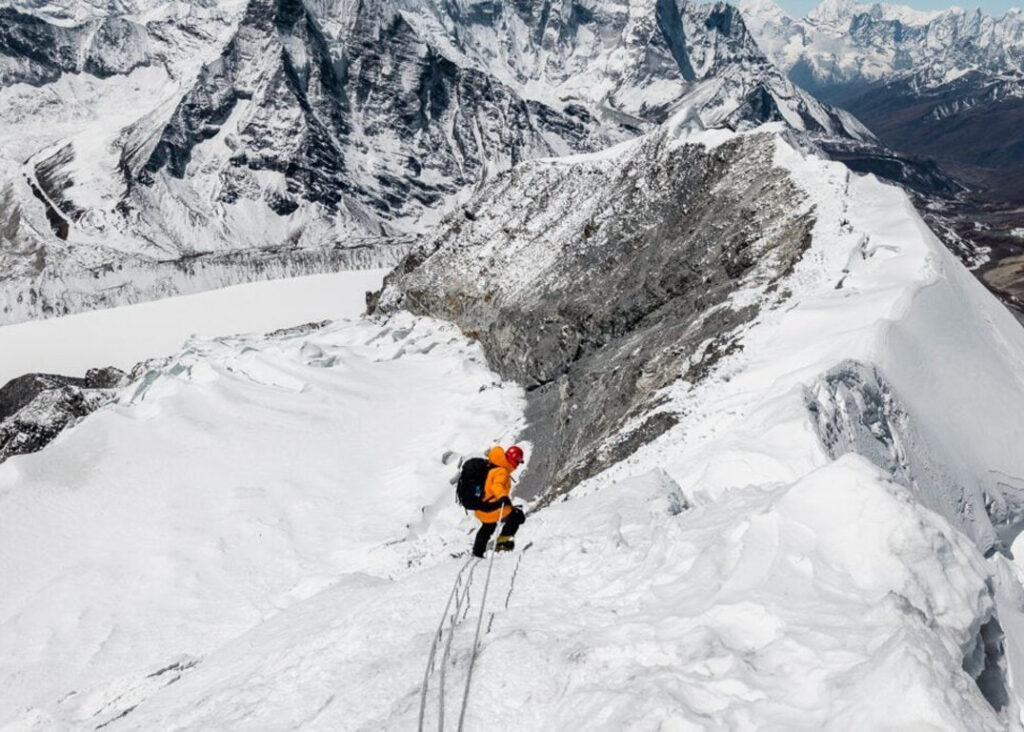
The temperatures during this time range from 5°C (41°F) to 10°C (50°F) at night, while daytime temperatures can reach 20°C (68°F). The combination of rain and cloud cover may limit visibility, obstructing panoramic views of the surrounding Himalayan peaks.
June
- June marks the onset of the monsoon season in Nepal, including Island Peak.
- Nighttime temperatures range from 5°C (41°F) to 10°C (50°F), while daytime temperatures average around 20°C (68°F).
- Rainfall becomes more frequent, with occasional heavy showers and cloudy skies.
- Climbers should be prepared for wet conditions, reduced visibility, and slippery trails due to rain.
July and August
- July and August are the peak months of the monsoon season.
- Nighttime temperatures range from 5°C (41°F) to 10°C (50°F), while daytime temperatures remain around 20°C (68°F).
- Heavy rainfall is common, with prolonged showers and overcast skies.
- The trails can be muddy and slippery, and there might be a higher risk of landslides.
- Climbing during this period is challenging, and the chances of clear views are limited.
Island Peak Weather Conditions on Autumn (September to November)
Autumn is widely regarded as the peak climbing season in Nepal, including Island Peak. During this period, the weather conditions are generally stable, with clear skies and excellent visibility. The temperatures begin to drop in September, with nighttime temperatures averaging around -5°C (23°F) and daytime temperatures ranging from 5°C (41°F) to 15°C (59°F).
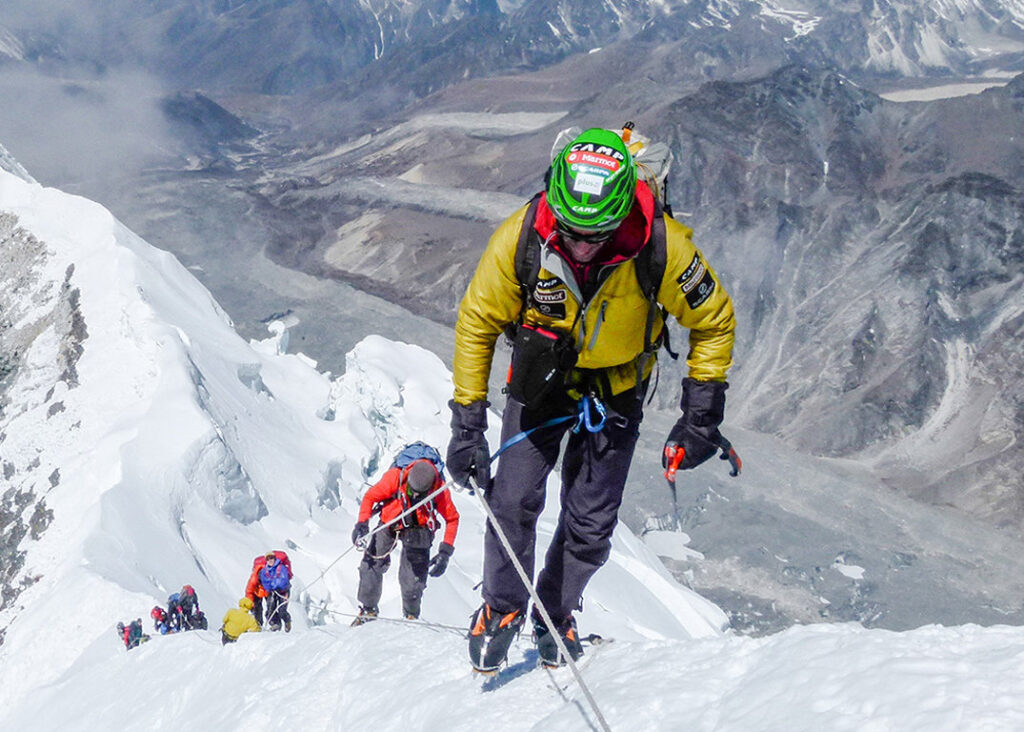
In October and November, the temperatures continue to decrease, with nighttime temperatures potentially falling as low as -20°C (-4°F).
Also Read: Top 10 Trekking Places in Nepal
However, during the day, temperatures hover around 5°C (41°F) to 10°C (50°F). Autumn offers the perfect combination of manageable cold weather and excellent climbing conditions.
September
- September marks the transition from monsoon to autumn.
- Nighttime temperatures begin to drop, averaging around -5°C (23°F), while daytime temperatures range from 5°C (41°F) to 15°C (59°F).
- The weather starts to stabilize, with decreasing rainfall and clearer skies.
- Climbers can expect improving visibility and manageable temperatures, making it an excellent time for climbing.
October and November
- October and November are considered the best months for climbing at Island Peak.
- Nighttime temperatures can drop to -20°C (-4°F), while daytime temperatures range from 5°C (41°F) to 10°C (50°F).
- The weather remains generally stable with clear skies and excellent visibility.
- Cold temperatures are manageable with proper gear, and climbers can enjoy the beauty of the Himalayas without the monsoon rains.
Island Peak Weather Conditions on Winter (December to February)
Winter at Island Peak is characterized by extremely cold temperatures and heavy snowfall. The mercury plunges below freezing, with nighttime temperatures reaching -20°C (-4°F) or lower. Daytime temperatures hover between -5°C (23°F) and 5°C (41°F).
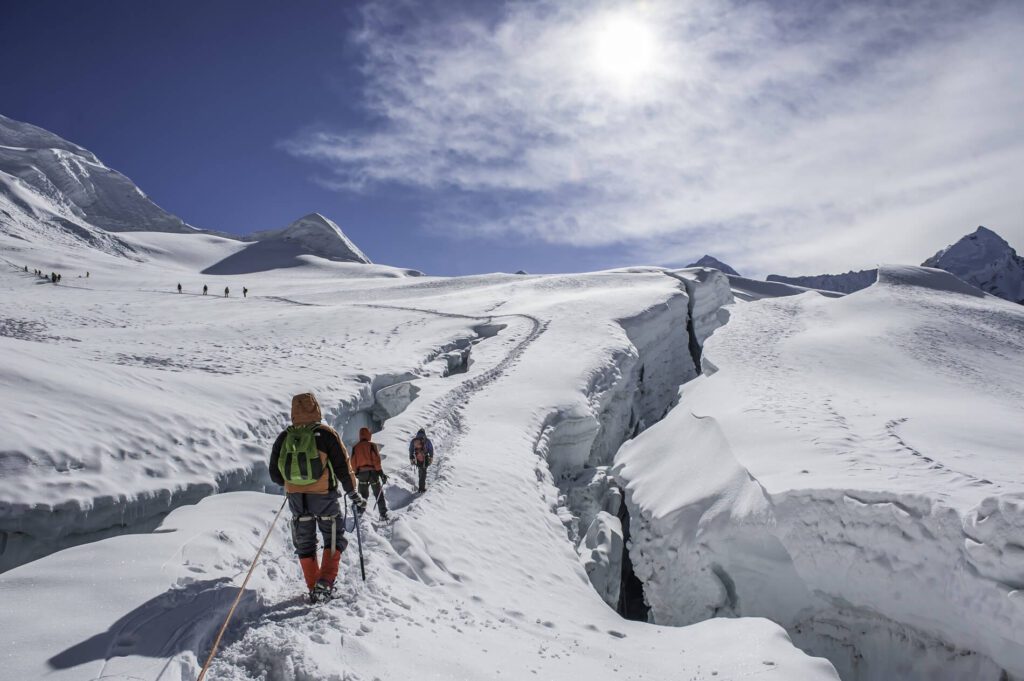
Snowfall can be substantial, making the climb more challenging. Strong winds and frostbite risks further add to the difficulty level. While some seasoned climbers might attempt the ascent during this period, it is generally less popular due to the harsh weather conditions.
December to February
- Winter brings harsh weather conditions to Island Peak.
- Nighttime temperatures fall below freezing, reaching -20°C (-4°F) or lower.
- Daytime temperatures range from -5°C (23°F) to 5°C (41°F).
- Heavy snowfall is common, making climbing challenging and risky.
- Strong winds and frostbite risks increase the difficulty level.
- While some experienced climbers may attempt the ascent during this period, it is less popular due to the extreme weather conditions.
Challenges Island peak
Embarking on the Island Peak trek is an exciting and challenging endeavor. It attracts adventurous souls seeking to conquer one of Nepal’s most popular trekking peaks. Before venturing into this thrilling journey, it is crucial to understand the difficulty level.
You May Also Like: Here what you need to know Before Summiting Island Peak, It’s Difficulties & Risks
Prepare yourself both physically and mentally. We will explore the factors that contribute to the difficulty of the Island Peak trek. And provide insights to help you assess whether you’re ready for this exhilarating adventure.
High Altitude
One of the primary challenges of the Island Peak trek is the high altitude you will encounter throughout the journey. Island Peak stands at an impressive elevation of 6,189 meters (20,305 feet). As you ascend, the air becomes thinner, and the oxygen levels decrease, leading to altitude-related challenges such as altitude sickness.
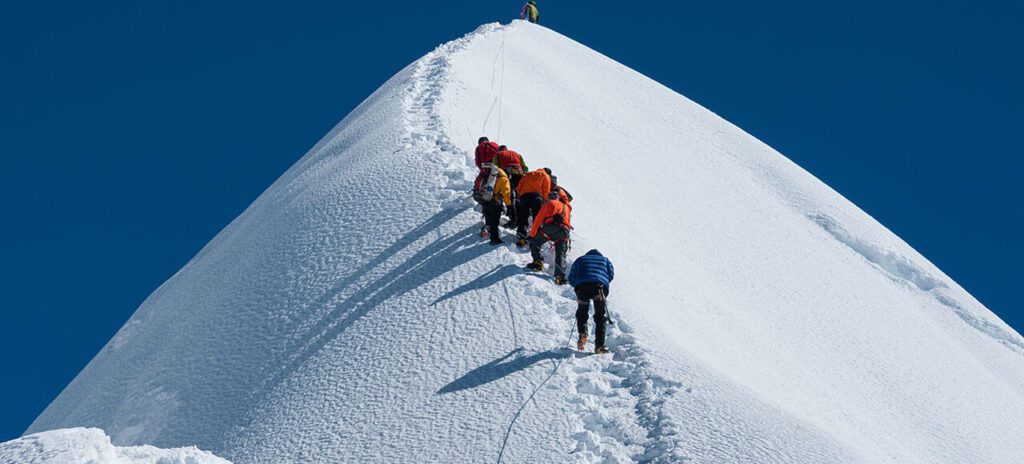
Proper acclimatization, gradual ascent, and listening to your body are essential to minimize the risks associated with high altitude.
Technical Climbing Skills
Island Peak is considered a trekking peak, but it involves technical climbing sections. The climb to the summit requires basic mountaineering skills, including using crampons, harnesses, ropes, and ice axes.
Prior experience in using these tools, as well as knowledge of rope techniques, glacier travel, and rock climbing, will greatly enhance your safety and confidence on the mountain. Having some prior mountaineering experience or having proper training with experienced guides is highly recommended.
Weather and Terrain
The Everest Region is known for its unpredictable weather conditions and rugged terrains. The trek to Island Peak involves traversing moraines, steep slopes, and glaciers. The weather can change rapidly, with snowfall, strong winds, and low temperatures.
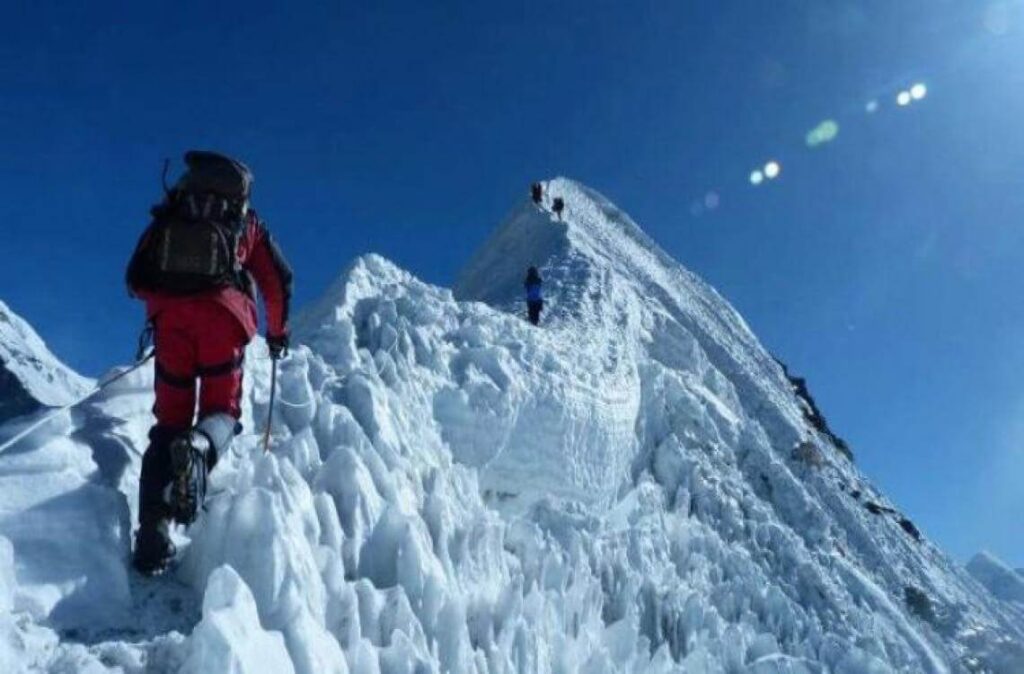
The challenging terrain, combined with varying weather patterns, demands physical strength, agility, and mental resilience.
Duration and Endurance
The Island Peak trek is not a short excursion. It typically takes around 18 to 20 days to complete the entire trek, including acclimatization days, which are crucial for your safety and well-being. The daily trekking distances can range from 4 to 8 hours, and the cumulative physical exertion can be demanding.
Popular: Everything about Island Peak Permit
Building your endurance through regular cardiovascular exercises and strength training prior to the trek is vital.
Remote and Basic Facilities
The Everest Region is a remote and rugged area with limited infrastructure. Tea houses and lodges along the trekking route provide basic accommodations and meals, but the facilities may be simple and basic. The lack of luxuries and amenities requires adaptability and a prepared mindset for a more rustic experience.







